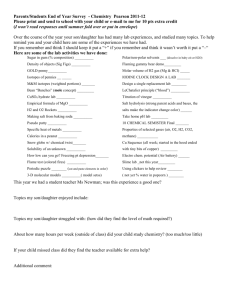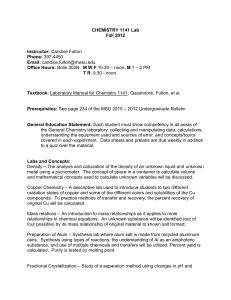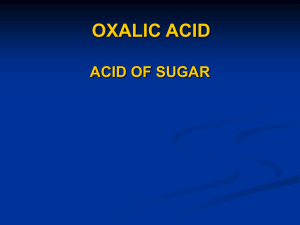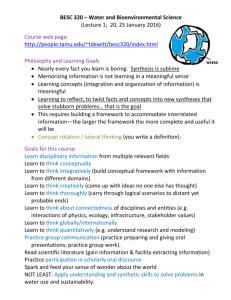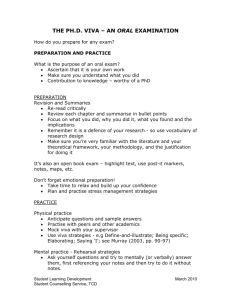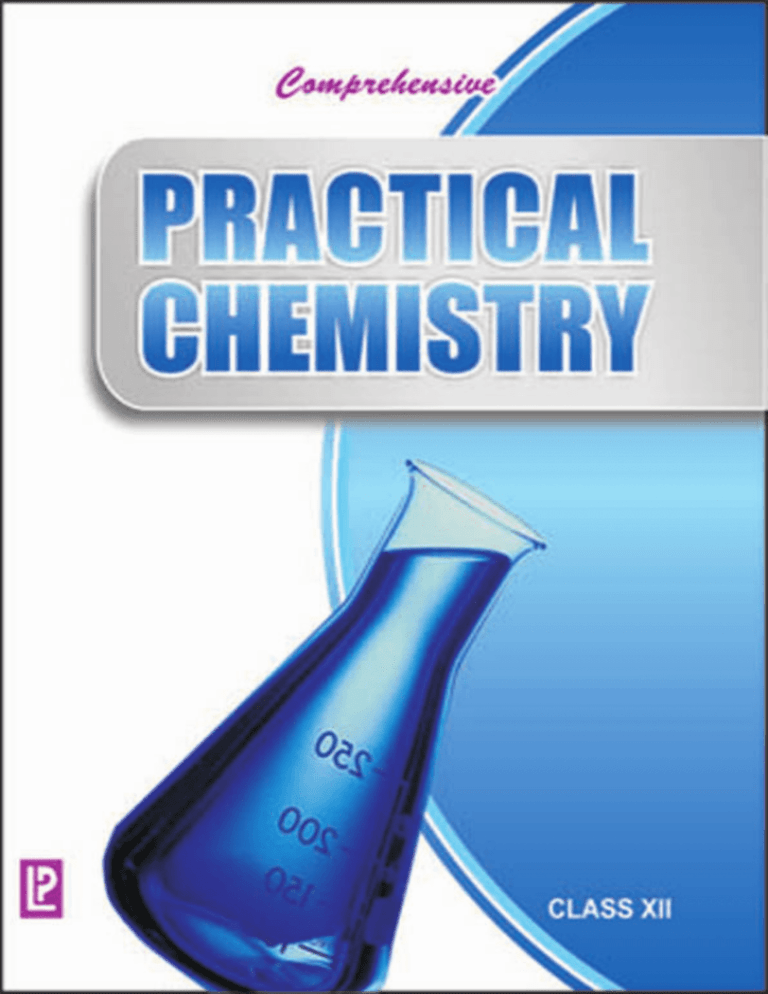
Comprehensive
PRACTICAL CHEMISTRY
FOR
CLASS XII
Strictly according to new curriculum prescribed by
Central Board of Secondary Education (CBSE)
and
State Boards of Chhattisgarh, Haryana, Bihar, Jharkhand, Kerala,
Mizoram, Meghalaya and other States following NCERT Curriculum
By
Dr. N.K. VERMA
Associate Professor
Chemistry Department
D.A.V. College
Chandigarh
Dr. B.K. VERMANI
Associate Professor
Chemistry Department
D.A.V. College
Chandigarh
Dr. NEERA VERMA
Associate Professor
Chemistry Department
M.C.M. D.A.V. College
Chandigarh
K.K. REHANI
Former Lecturer of Chemistry
S.G.G.S. College
Chandigarh
LAXMI PUBLICATIONS (P) LTD
BANGALORE N CHENNAI
JALANDHAR
N
KOLKATA
N
COCHIN
N
GUWAHATI
N
HYDERABAD
N
LUCKNOW
N
MUMBAI
N
RANCHI
NEW DELHI N BOSTON, USA
© All rights reserved with the Publisher. No part of this publication may be
reproduced, stored in a retrieval system, or transmitted in any form or by any means,
electronic, mechanical, photocopying, recording or otherwise without the prior
written permission of the publisher.
Published by :
LAXMI PUBLICATIONS (P) LTD
113, Golden House, Daryaganj,
New Delhi-110002
Phone : 011-43 53 25 00
Fax : 011-43 53 25 28
www.laxmipublications.com
info@laxmipublications.com
Price : ` 170.00 Only.
New Edition
OFFICES
Bangalore
Cochin
Hyderabad
Kolkata
Mumbai
080-26 75 69 30
0484-237 70 04, 405 13 03
040-24 65 23 33
033-22 27 43 84
022-24 91 54 15, 24 92 78 69
T12-8947-170-COMP. (P) CHEMISTRY XII
Typeset at : Excellent Graphics, Delhi.
Chennai
Guwahati
Jalandhar
Lucknow
Ranchi
044-24 34 47 26
0361-251 36 69, 251 38 81
0181-222 12 72
0522-220 99 16
0651-220 44 64
C—6057/012/12
Printed at : International Print-O-Pac Limited, Noida
CONTENTS
Chapter
Pages
Syllabus
1.
(xiii)—(xiv)
INTRODUCTION TO BASIC LABORATORY EQUIPMENT
Viva questions with answers
2.
...
SURFACE CHEMISTRY
Exp-2.1
Exp-2.2
Exp-2.3
Exp-2.4
Exp-2.5
Exp-2.6
Exp-2.7
:
:
:
:
:
:
:
...
...
...
...
...
...
11
12
12
13
15
15
...
17
...
20
...
22
...
...
23
25
CHEMICAL KINETICS
Exp-3.1
Exp-3.2
Exp-3.3
9
10–27
To prepare colloidal solution (sol) of starch
To prepare a colloidal solution of gum
To prepare colloidal solution (or sol) of egg albumin
To prepare ferric hydroxide, [Fe(OH)3] sol
To prepare aluminium hydroxide, [Al(OH)3] sol
To prepare colloidal solution of arsenious sulphide, [As2 S3]
To study the dialysis of starch sol containing sodium chloride through a cellophane or parchment paper
Exp-2.8 : Compare the precipitation values of sodium chloride,
barium chloride and aluminium chloride for arsenious
sulphide sol
Exp-2.9 : To study the effectiveness of different common oils (castor
oil, cotton seed oil, coconut oil, kerosene oil, mustard oil) in
forming emulsions
Exp-2.10 : To compare the effectiveness of a number of emulsifying
agents in forming emulsions
Viva questions with answers
3.
1–9
28–37
: To study the effect of concentration on the rate of reaction
between sodium thiosulphate and hydrochloric acid
...
: To study the effect of change in temperature on the rate
of reaction between sodium thiosulphate and hydrochloric
acid
...
: To study the reaction rate of reaction of iodide ions with
hydrogen peroxide at different concentrations of iodide
ions
...
(v)
29
31
33
( vi )
Exp-3.4
: To study the reaction rate of the reaction between potassium iodate (KIO3) and sodium sulphite (Na2SO3) using
starch solution as indicator
Viva questions with answers
4.
THERMOCHEMISTRY
Exp-4.1 : Determine the enthalpy of neutralisation of hydrochloric
acid with sodium hydroxide solution
Exp-4.2 : Determine the enthalpy of dissolution of given solid copper
sulphate (CuSO4.5H2O) in water at room temperature
Exp-4.3 : Determinate the water equivalent (W) of polythene bottle
(calorimeter)
Exp-4.4 : Determine the enthalpy change during the interaction
(hydrogen bond formation) between acetone and chloroform
Viva questions with answers
5.
: To set up simple Daniell cell and determine its e.m.f.
: To set up simple Daniell cell using salt bridge and
determine its e.m.f.
Exp-5.3 : To study the variation of cell potential in Zn | Zn2+ || Cu2+ | Cu
cell with change in concentration of electrolytes (CuSO4
and ZnSO4) at room temperature
Viva questions with answers
34
36
38–46
...
39
...
41
...
43
...
...
44
45
ELECTROCHEMISTRY
Exp-5.1
Exp-5.2
6.
...
...
47–52
...
49
...
50
...
...
51
52
CHROMATOGRAPHY
53–59
Exp-6.1
: Separate the coloured components present in the mixture
of red and blue inks by ascending paper chromatography
and find their Rf values
...
Exp-6.2 : Separate the coloured components present in the given
grass/flower by ascending paper chromatography and
determine their Rf values
...
Exp-6.3 : Separate Co+2 and Ni2+ ions present in the given mixture
by using ascending paper chromatography and determine
their Rf values
...
Viva questions with answers
...
7.
PREPARATION OF INORGANIC COMPOUNDS
: To prepare a pure sample of ferrous ammonium sulphate
(Mohr’s salt), [FeSO4 . (NH4)2 SO4 . 6H2O]
Exp-7.2 : To prepare a pure sample of potash alum (Fitkari),
[K2SO4.Al2 (SO4)3.24H2O]
Exp-7.3 : To prepare a pure sample of the complex potassium trioxalatoferrate (III), K3[Fe(C2O4)3] . 3H2O
Viva questions with answers
56
57
58
58
60–69
Exp-7.1
...
65
...
66
...
...
67
68
( vii )
8.
PREPARATION OF ORGANIC COMPOUNDS
Exp-8.1 : To prepare a sample of acetanilide from aniline
Exp-8.2 : To prepare a sample of dibenzal acetone
Exp-8.3 : To prepare a sample of p-nitro acetanilide from acetanilide
Exp-8.4 : To prepare 2-naphthol aniline dye
Viva questions with answers
9.
70–77
...
...
...
...
...
TESTS FOR THE FUNCTIONAL GROUPS PRESENT IN ORGANIC
COMPOUNDS
: Identify the functional group present in the given organic
compound
Viva questions with answers
70
72
73
75
76
78–96
Exp-9.1
...
...
10. STUDY OF CARBOHYDRATES, FATS AND PROTEINS IN PURE
FORM AND DETECTION OF THEIR PRESENCE IN GIVEN FOOD
STUFFS
Exp-10.1
Exp-10.2
Exp-10.3
Exp-10.4
:
:
:
:
To study some simple tests of carbohydrates
To study some simple tests of oils and fats
To study some simple tests of proteins
To detect the presence of carbohydrates, fats and proteins
in the following food stuffs : Grapes, potatoes, rice, butter,
biscuits, milk, groundnut, boiled egg
Viva questions with answers
94
95
97–107
...
...
...
99
101
104
...
...
105
106
11. VOLUMETRIC ANALYSIS
108–162
M
solution of oxalic acid from
10
crystalline oxalic acid
N
Exp-11.2 : Prepare 250 ml of a
solution of oxalic acid from
10
crystalline oxalic acid
Exp-11.1 : Prepare 250 ml of
...
119
...
121
...
122
...
123
M
solution of ferrous ammonium sulphate (Mohr’s
20
salt). Using this solution find out the molarity and strength
of the given KMnO4 solution
...
128
Exp-11.3 : Preparation of 250 ml of
Exp-11.4 : Prepare 250 ml of
M
solution of Mohr’s salt
20
N
solution of Mohr’s salt
20
Exp-11.5 : Prepare
( viii )
Exp-11.6 : Prepare a solution of ferrous ammonium sulphate (Mohr’s
salt) containing exactly 17.0 g of the salt in one litre. With
the help of this solution, determine the molarity and the
concentration of KMnO4 in the given solution
...
M
ferrous ammonium sulphate (Mohr’s salt)
20
solution. Find out the percentage purity of impure KMnO4
sample 2.0 g of which have been dissolved per litre
...
Exp-11.8 : Determine the equivalent mass and number of molecules
of water of crystallisation in a sample of Mohr’s salt,
M
FeSO4(NH4)2 SO4 . nH2O. Provided
KMnO4
...
100
130
Exp-11.7 : Prepare
M
solution of oxalic acid. With its help, determine
50
the molarity and strength of the given solution of potassium
permanganate (KMnO4)
...
Exp-11.10 : Find out the percentage purity of impure sample of oxalic
M
acid. You are supplied
KMnO4 solution
...
100
Exp-11.11 : The given solution has been prepared by dissolving 1.6 g of
an alkali metal permanganate per litre of solution. Determine
volumetrically the atomic mass of the alkali metal. Prepare
M
Mohr’s salt solution for titration
...
20
Exp-11.12 : Determine the percentage composition of a mixture of
132
134
Exp-11.9 : Prepare
LM
MN
OP
PQ
136
138
140
OP
PQ
LM
MN
COOH
COONa
sodium oxalate ⏐
and oxalic acid ⏐
. 2H 2O .
COOH
COONa
M
KMnO4 solution
...
100
Exp-11.13 : You are provided with a partially oxidised sample of ferrous
sulphate (FeSO4 . 7H2O) crystals. Prepare a solution by
dissolving 14.0 g of these crystals per litre and determine
Provided
the percentage oxidation of the given sample. Given
M
100
KMnO4 solution
...
2+
Exp-11.14 : Calculate the percentage of Fe ions in a sample of ferrous
sulphate. Prepare a solution of the given sample having
strength exactly equal to 14.0 g/litre. Provided
143
M
KMnO4 ...
100
145
147
( ix )
N
Mohr’s salt solution. Using this solution, deter20
mine the normality and strength of the given potassium
permanganate solution
...
Exp-11.15 : Prepare
N
solution of oxalic acid. Using this solution, find
20
out strength and normality of the given potassium permanganate solution
...
Exp-11.17 : Determine the percentage purity of the given sample of
oxalic acid. Ask for your requirement
...
Exp-11.18 : Determine the percentage composition of a mixture of
150
Exp-11.16 : Prepare
LM
MN
OP
PQ
LM
MN
152
154
OP
PQ
COOH
COONa
sodium oxalate ⏐
and oxalic acid ⏐
. 2H 2O .
COOH
COONa
N
KMnO4
20
Exp-11.19 : Determine the equivalent mass and number of molecules
of water of crystallisation in a sample of Mohr’s salt
Provided
FeSO4 (NH4)2 SO4.nH2O. Provided
N
KMnO4
20
Viva questions with answers
...
155
...
158
...
160
12. QUALITATIVE ANALYSIS
Exp-12.1 : To analyse the given salt for acidic and basic radicals
Exp-12.2 : To analyse the given salt for acidic and basic radicals
Viva questions with answers
163–212
...
...
...
201
203
206
INVESTIGATORY PROJECTS
Projects
1.
STUDY OF OXALATE ION CONTENT IN GUAVA FRUIT
Exp-1
2.
: To study the presence of oxalate ion content in guava fruit
at different stages of ripening
...
STUDY OF THE QUANTITY OF CAESIN PRESENT IN DIFFERENT
SAMPLES OF MILK
Exp-1
: To study the quantity of caesin present in different samples
of milk
...
215
215
216
217
(x)
3.
PREPARATION OF SOYABEAN MILK AND ITS COMPARISON
WITH NATURAL MILK
Exp-1
4.
Exp-2
: To compare the rates of fermentation of the following fruit
or vegetable juices
(i) Apple juice (ii) Orange juice (iii) Carrot juice
...
: To compare the rates of fermentation of the given samples
of wheat flour, gram flour, rice and potatoes
...
220
: To extract essential oils present on Saunf (Aniseed), Ajwain
(Carum) and Illaichi (Cardamom)
...
: To detect the presence of adultrants in fat, oil and butter
: To detect the presence of adultrants in sugar
: To detect the presence of adultrants in samples of chilli
powder, turmeric powder and pepper
: To prepare potash alum from scrap aluminium
222
223
225
225
227
...
...
227
228
...
228
PREPARATION OF AN ALUM FROM SCRAP ALUMINIUM
Exp-1
9.
: To study the effect of potassium bisulphite as food preservative under various conditions (Concentration, time and
temperature)
...
STUDY OF ADULTRANTS IN FOOD-STUFFS
Exp-1
Exp-2
Exp-3
8.
219
EXTRACTION OF ESSENTIAL OILS PRESENT IN SAUNF
(ANISEED), AJWAIN (CARUM) AND ILLAICHI (CARDAMOM)
Exp-1
7.
218
COMPARATIVE STUDY OF THE RATE OF FERMENTATION OF VARIOUS
FOOD MATERIALS
221
Exp-1
6.
: Preparation of soyabean milk and its comparison with the
natural milk with respect to curd formation, effect of
temperature and taste
...
STUDY OF EFFECT OF POTASSIUM BISULPHITE AS FOOD
PRESERVATIVE UNDER VARIOUS CONDITIONS
Exp-1
5.
218
229
...
229
STUDY OF THE EFFECT OF METAL COUPLING ON THE RUSTING
OF IRON
230
Exp-1
231
: To study the effect of metal coupling on rusting of iron
...
10. PREPARATION OF RAYON THREAD FROM FILTER PAPER
Exp-1
233
: To prepare rayon threads from filter papers using cuprammonium process
...
11. DYEING OF FABRICS
Exp-1
: To dye wool and cotton clothes with malachite green
233
234
...
236
( xi )
12. STERILIZATION OF WATER WITH BLEACHING POWDER
Exp-1
237
: Determination of the dosage of bleaching powder required
for sterilization or disinfection of different samples of water ...
13. SETTING OF CEMENT
Exp-1
Exp-2
240
: To study the setting of mixtures of cement with lime, sand
of different qualities, rice husk, fly-ash, etc. (with respect
to volume and strength)
...
: To study the setting of mixtures of cement with sand, lime
and fly-ash with respect to time and strength
...
14. STUDY OF PRESENCE OF INSECTICIDES AND PESTICIDES IN
FRUITS AND VEGETABLES
Exp-1
: To study the presence of insecticides/pesticides (nitrogencontaining) in various fruits and vegetables
: To analyse the given samples of commercial antacids by
determining the amount of hydrochloric acid they can
neutralize
...
: To analyse a sample of brass qualitatively
APPENDICES
APPENDIX-I
Atomic Masses of Some Common Elements
APPENDIX-II
Preparation of Common Reagents used in the Chemical Laboratory
LOGARITHMIC TABLES
242
243
244
...
16. STUDY OF CONSTITUENTS OF AN ALLOY
Exp-1
241
242
15. COMPARATIVE STUDY OF COMMERCIAL ANTACIDS
Exp-1
237
245
247
...
248
249–254
...
250
...
251
(i)–(iv)
PREFACE
We are pleased to present the revised edition of the ‘Comprehensive Practical
Chemistry’ for Class XII students. The book has been written strictly according to
the new syllabus prescribed by Central Board of Secondary Education. We hope that
the book will be quite helpful to the students in acquiring the skills of various laboratory
techniques. Some of the outstanding features of the book are:
¤ Simple language and lucid style.
¤ Wherever required, a large number of illustrations have been given to clarify
the use of various apparatuses used in laboratory.
¤ The theoretical aspects of each experiment have been discussed briefly along
with the experiment.
¤ In volumetric analysis calculations based on normality as well as on molarily
have been given.
¤ In qualitative inorganic analysis, the various tests have been given in a
systematic way in tabular form.
¤ In order to guide the students about recording the experiment in the notebook, a specimen record of analysis of a salt has been given in the chapter
on qualitative analysis.
¤ A large number of solved viva questions have been included in each chapter.
We sincerely hope that the book will be appreciated by our learned colleagues
and students. We shall be glad to receive constructive suggestions for the further
improvement of the book.
—AUTHORS
( xii )
SYLLABUS FOR PRACTICALS
CHEMISTRY
Class XII
Evaluation Scheme for Examination
Marks
Volumetric Analysis
Salt Analysis
Content Based Experiment
Class Record, Project Work and Viva
10
8
6
6
Total
30
Micro-chemical methods are available for several of the practical experiments.
Wherever possible, such techniques should be used.
A.
B.
Surface Chemistry
(Periods 5)
(a) Preparation of one lyophilic and one lyophobic sol.
Lyophilic sol—starch, egg albumin and gum.
Lyophobic sol—aluminium hydroxide, ferric hydroxide, arsenious sulphide.
(b) Dialysis of sol-prepared in (a) above.
(c) Study of the role of emulsifying agents in stablizing the emulsion of different oils.
Chemical Kinetics
(Periods 4)
(a) Effect of concentration and temperature on the rate of reaction between sodium
thiosulphate and hydrochloric acid.
(b) Study of reaction rates of any one of the following :
(i) Reaction of iodide ion with hydrogen peroxide at room temperature using different concentration of iodide ions.
(ii) Reaction between potassium iodate, KIO3 and sodium sulphite : (Na2SO3) using
starch solution as indicator (clock reaction).
C.
Thermochemistry
(Periods 4)
Any one of the following experiments
(i) Enthalpy of dissolution of copper sulphate or potassium nitrate.
(ii) Enthalpy of neutralization of strong acid (HCl) and strong base (NaOH).
(iii) Determination of enthalpy change during interaction (Hydrogen bond formation)
between acetone and chloroform.
D. Electrochemistry
(Periods 2)
2+
2+
Variation of cell potential in Zn | Zn || Cu | Cu with change in concentration of
electrolytes (CuSO4 or ZnSO4) at room temperature.
( xiii )
( xiv )
E.
F.
G.
H.
I.
J.
K.
Chromatography
(Periods 2)
(i) Separation of pigments from extracts of leaves and flowers by paper chromatography
and determination of Rf values.
(ii) Separation of constituents present in an inorganic mixture containing two cations
only (constituents having wide difference in Rf values to be provided).
Preparation of Inorganic Compounds
(Periods 4)
(i) Preparation of double salt of ferrous ammonium sulphate or potash alum.
(ii) Preparation of potassium ferric oxalate.
Preparation of Organic Compounds
(Periods 2)
Preparation of any one of the following compounds
(i) Acetanilide
(ii) Di-benzal acetone
(iii) p-Nitroacetanilide
(iv) Aniline yellow or 2-Napthol aniline dye.
Test for the functional groups present in organic compounds :
(Periods 6)
Unsaturation, alcoholic, phenolic, aldehydic, ketonic, carboxylic and amino (primary) groups.
Characteristic tests of carbohydrates, fats and proteins in pure samples and
their detection in given food stuffs.
(Periods 4)
Determination of concentration/molarity of KMnO4 solution by titrating it
against a standard solution of :
(Periods 8)
(i) Oxalic acid
(ii) Ferrous ammonium sulphate.
(Students will be required to prepare standard solutions by weighing themselves).
Qualitative Analysis
(Periods 14)
Determination of one cation and one anion in a given salt.
Cations: Pb2+, Cu2+, As3+, Al3+, Fe3+, Mn2+, Zn2+, Co2+, Ni2+, Ca2+, Sr2+, Ba2+, Mg2+, NH4+
2−
−
−
3−
2−
–
– –
–
Anions: CO32− , S2–, SO 2−
3 , SO 4 , NO 2 , NO 3 , Cl , Br , I , PO 4 , C 2 O 4 , CH3COO
(Note : Insoluble salts excluded)
PROJECTS
Scientific investigations involving laboratory testing and collecting information from
other sources.
A Few Suggested Projects
• Study of presence of oxalate ions in guava fruit at different stages of ripening.
• Study of quantity of casein present in different samples of milk.
• Preparation of soyabean milk and its comparison with the natural milk with respect
to curd formation, effect of temperature, etc.
• Study of the effect of potassium bisulphate as food preservative under various
conditions (temperature, concentration, time, etc.)
• Study of digestion of starch by salivary amylase and, effect of pH and temperature on it.
• Comparative study of the rate of fermentation of following materials : wheat flour,
gram flour, potato juice, carrot juice, etc.
• Extraction of essential oils present in Saunf (aniseed), Ajwain (carum), Illaichi
(cardamom).
• Study of common food adulterants in fat, oil, butter, sugar, turmeric powder, chilli
powder and pepper.
Note : Any investigatory project, which involves about 10 periods of work, can be chosen
with the approval of the teacher.
1
CHAPTER
INTRODUC TION TO BASIC
LABORATORY EQUIPMENT
1.1.
CHEMISTRY LABORATORY
A chemistry laboratory is a workshop for chemists. Here students learn the techniques of the
preparation, identification and estimation of chemical substances. Before starting experiment,
a student must know from where to get the apparatus required for the given experiment and
the placement of the chemicals to be used. A student must know the proper use of each equipment
and the precautions to be observed while working in the laboratory. A chemistry laboratory is
provided with the following fittings with which the student must become familiar.
1. Demonstration Table
Before starting experiment, the teacher gives instructions and demonstrates the concerned
experiment on demonstration table. In chemistry laboratory, no seats are made available to
the students, so students stand around demonstration table and note the instructions from
teacher.
2. Students’ Working Table
A number of wooden or concrete tables are provided for working. Generally, four students (two
on each side) work on one table. Each seat is provided with:
(a) Reagent shelves. Reagents or chemicals to be used are placed on the reagent shelf.
These are the reagents which are commonly used. For example, all dilute and concentrated
acids such as H2SO4, HCl, HNO3, etc. and bases like NaOH, NH4OH, etc.
(b) Sinks and water taps. A sink and a water tap is fitted between every two reagent
shelves. On either side of the sink, usually two taps are fitted for supply of water.
(c) Gas taps. These taps are fitted on the seats for supply of petrol gas to the burners.
Sometimes kerosene is used for producing gas in place of petrol.
3. Side Shelves
Mostly there are two big shelves fitted on the walls of the laboratory. Reagents and chemicals,
which are less frequently used, are placed in these shelves. Sometimes solid chemicals are
placed in a separate shelf.
4. Fume Cup-board
There is at least one fume cup-board in the corner of the laboratory. All experiments giving out
poisonous gases or vapours are performed in this cup-board.
5. Balance Room
It is a small room attached to each laboratory. Here, a number of balances are kept for weighing
the substances.
1
2
COMPREHENSIVE PRACTICAL CHEMISTRY—XII
6. Exhaust Fans
Two exhaust fans are provided at the two corners of the laboratory for the removal of the
poisonous gases and vapours from the laboratory.
1.2.
COMMON LABORATORY APPARATUS
The apparatus which is commonly used by a student is described below:
Test tube
Centrifuging
tube
Funnel stand
Tripod stand
Glass rod
Platinum wire
Boiling
tube
Test tube
brush
Gas detector
Funnel
Wash bottle
Wire gauze
China dish
Blue glass
Charcoal block
Watch glass
Mouth blow
pipe
Fig. 1.1. Apparatus used in chemistry laboratory.
Charcoal
borer


